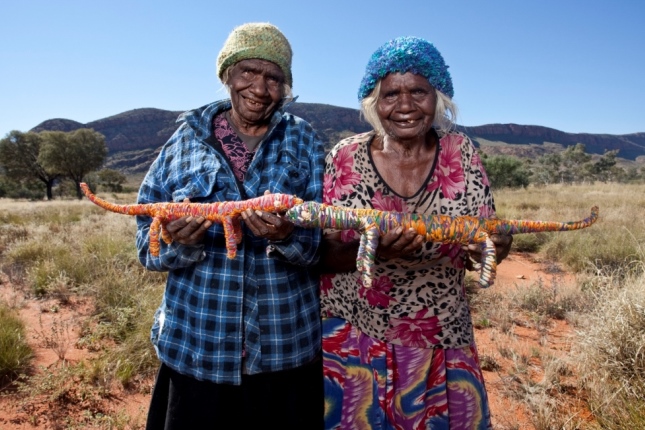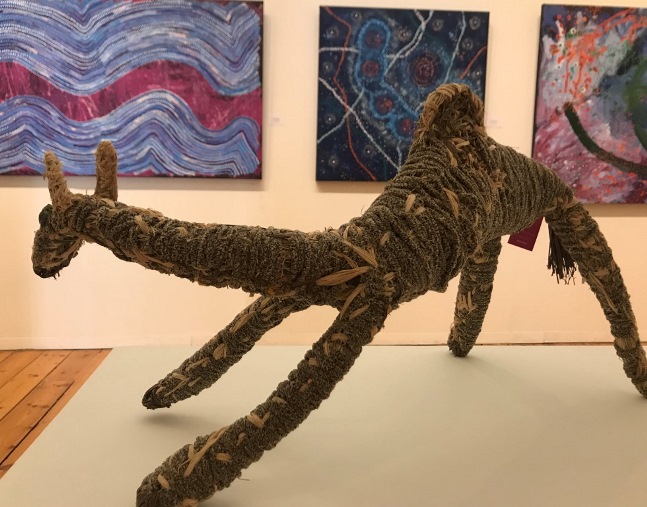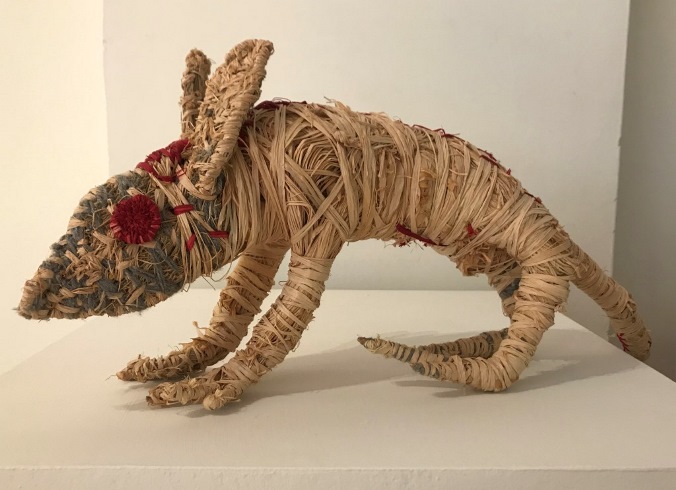The Tjanpi Desert Weavers Roving Art Centre Model

The Tjanpi Desert Weavers have just had their first exhibition at Japingka Gallery. This article is based on discussions between Annieka Skinner who is a Tjanpi Field Officer and Cynthia Burke, Indigenous artist as well as Arts and Culture Assistant for Tjanpi Desert Weavers.
Fibre art has been part of the artistic output in APY Lands and the Western Desert for over ten years. The first weaving workshop was held in Papalunkutja, Western Australia in 1995 and it quickly spread across the region.
There are over four hundred Tjanpi artists across twenty-six communities in the tri-state border region of Northern Territory, Western Australia and South Australia. The participating artists range from twelve years to eighty-five years old and are exclusively women.

Tjanpi operates a roving art centre model, with two field officers and field officer assistants travelling out to each community once a month to collect artwork, distribute materials, and conduct skills development workshops.
Tjanpi work builds on the long history that Ngaanyatjarra, Pitjantjatjara and Yankunytjatjara people have with using natural fibres such as hair and grass. Prior to first white contact, women on the NPY lands used to make manguri, a small ring made from hair, grass and wipya (emu feathers) to protect themselves when carrying piti (long dishes) on their heads. Women adapted this style of wrapping fibres into the construction of coiled baskets in 1995 and then later sculptural forms.

Tjanpi sculptures have been created to express Tjukurrpa or Dreaming stories. The act of collecting minarri, the grass used in baskets and sculptures, constantly reaffirms their relationship and responsibilities to Country.
Here is how the Project officers describe their work;
"We have a routine that we follow on each visit to the different communities to collect work. We visit the store, clinic and art centre and find out which artists are in community at that time, who has created Tjanpi work and then we go around visiting people and sometimes we go out collecting grass.
The women enjoy making sculptures. The young girls enjoy learning from their mothers and grandmothers who teach them how to weave. They like being able to sell the artworks to Tjanpi for food or petrol so they can go out bush for tinka (goanna).
Some of the artists get really happy when a basket or sculpture is included in an upcoming exhibition. They tell lots of people their works have been sent off. They then wait for the extra money that an exhibition brings in for their families."
Summertime is a favourite time of the year because the artists can sit out under the trees and make their weavings. They will tell you that anytime is a good time of year in Tjanpi except when it gets cold in winter and artists have to make artwork in front of a heater or in a sheltered sunny spot.
If you ask the artists what is the single thing would make a significant difference for them, they will tell you that it would be the ability to go out bush more. They love to do trips out. The field workers enjoy taking artists out bush and travelling to different communities and buying Tjanpi and bringing them back to the Tjanpi office in Warakurna. The artists enjoy travelling to cities for exhibitions and art fairs like Revealed in Perth.

Cynthia Burke spoke with Japingka during her recent visit to the Revealed art fair in Fremantle.
"I learned to weave from my Mum. I've been involved for years as an adult. Sometimes I do it at night time or on the weekend. It's good and some days I weave with other ladies. I feel good when I see my weaving and painting in exhibitions. The animals are my favourite. I like to do cats or dogs or lizards. Sometimes a camel. Sometimes we do funny faces, smiley faces or sad faces. We like to make each other laugh. The women I work with have always been my friends. They are people I've known my whole life. We have some younger people learning weaving and painting now too. As well as weaving I paint every morning at the Art Centre. I like doing landscapes best."
The future looks good for Tjanpi Desert Weavers and the production of fine art from these lands. As Cynthia Burke will confidently tell you,
"When the old artists pass away, that the young ladies will keep Tjanpi going and going."
Special thanks to Tjanpi Desert Weavers for photos of their artists on Country.


